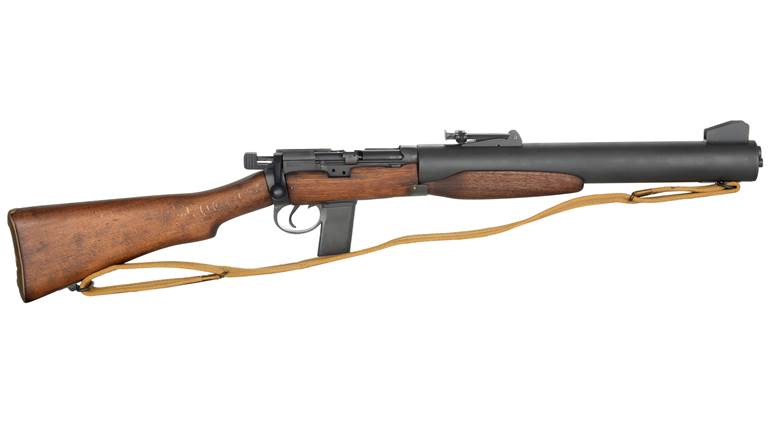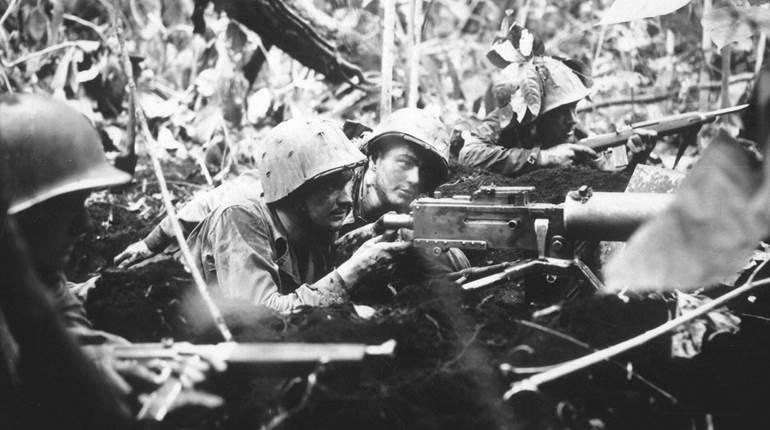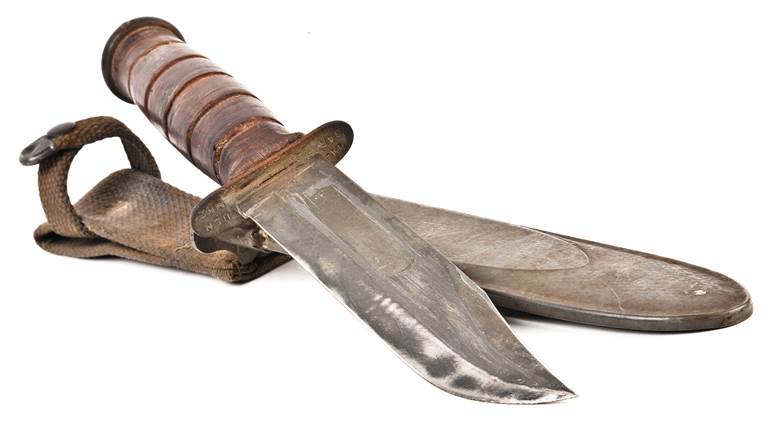
The United States military adopted its first rifle grenade in 1911. Designed by U.S. Army Ordnance Officer Col. E.B. Babbitt, the grenade had a long metal stem that was inserted into the barrel of the M1903 rifle and launched by means of a special blank cartridge. The “Babbitt” rifle grenade was not an ideal design; the metal rod could damage the barrel’s rifling, and the grenade’s overall length made it awkward for a soldier to carry.
When the United States entered the First World War in the spring of 1917, the Babbitt was still the only standardized rifle grenade, but it is doubtful it was used for anything beyond training purposes. Rifle grenades had proven to be effective during the trench warfare that had been raging in France since 1914. Understandably, the American Expeditionary Force desired to have a battle-proven rifle grenade launcher for issue to our troops, but lacking a suitable design, we turned to our French allies. The standard French rifle grenade was the “V-B,” named after its developers Jean Viven and Gustave Bessiere. The launcher, called a “tromblon,” was a heavy metal cup designed to fit over the muzzle of the rifle. The cylindrical grenade had a hole through the middle and, when inserted into the launcher, was fired by means of a standard ball cartridge; the bullet passed through the hole in the grenade and armed the fuse. The escaping gas of the cartridge permitted the grenade to be fired at distances up to 200 yards. The United States adopted copies of the French V-B launchers that were adapted for the M1903 and M1917 rifles.

Since the V-B saw wide use in the war by the French and performed satisfactorily, it was envisioned that the French-pattern rifle grenades could be used with the American V-B launchers. However, there were initially a number of problems encountered with the American-made grenades due to several factors, including not making the necessary allowances to account for the differences between the French and American rifle cartridges. These problems were eventually solved, and orders were placed for more than 30 million grenades for the American V-B launchers. The fragmentation grenade, which weighed about 17 ozs., was designated as the “V-B Rifle Grenade, Mark I.”

By August 1918, daily production of the Mark I V-B grenades reached 130,000 and had increased to about 250,000 by the time of the Armistice in November. The initial problems encountered, however, resulted in fewer V-B launchers being used by our Doughboys during the war than would otherwise have been the case. In any event, the V-B was the only type of rifle grenade to see substantive use by American armed forces during World War I.
Following the Armistice, the U.S. Army was ambivalent about rifle grenades. As stated in a post-war Ordnance report:
“The continuance of rifle grenades on the Table of Basic Allowance was discussed pro and con during the post-World War I period. Criticism was expressed because of their limited range, inaccuracy, exposure of the firer to the enemy, small danger radius, and weight. Because of the desire for an increased range, it was felt that the small-bore service rifle was not rugged enough in design to withstand the heavier shocks resulting from propelling grenades weighing approximately 1.5 pounds.”
During the interim between the world wars, there were two schools of thought throughout the Army regarding the best method for discharging grenades. One advocated for the development of a better type of launcher to be attached to the service rifle, and the other contended that a separate discharger or projector, of sturdier construction than the service rifle, which could combine the discharge of signals and grenades, was preferable. The balance swung back and forth between the methods of firing grenades, with development being carried out on both types.

In 1923, the Chief of Infantry recommended that all rifle grenades be dropped from the Table of Basic Allowance and declared obsolete. This obviously signaled an end to the issuance of the V-B grenade launchers to the U.S. Army. There were some sporadic efforts to develop improved grenade launchers during the 1920s and into the 1930s, with no real progress. The adoption of the M1 Garand rifle in 1936 resulted in further development of a new grenade launcher being put on hold until Ordnance engineers could study the challenges that designing a launcher for the gas-operated semi-automatic rifle would pose. In reality, a grenade launcher for the M1 rifle wasn’t a high-priority project. The Army’s antipathy toward the rifle grenade was such that, in 1939, the Ordnance Dept.’s stated policy was “… there should be no rifle grenades … provided for use … Further use of the service rifle for the general purpose of firing rifle grenades (is) prohibited.” Thus, on the eve of the Second World War, the U.S. Army did not have a rifle grenade launcher in inventory and no firm plans for the development of one.
While the Army abandoned the V-B rifle grenade launcher in the early 1920s, the U.S. Marine Corps quietly held on to it. Marine Corps recruits had received instruction on the V-B rifle grenade as part of their basic training regime from the 1920s into the early 1940s. The launchers saw a modicum of combat action in Nicaragua in the late 1920s and early 1930s. The M1903 rifle fitted with the Mark IV V-B launcher continued to be listed in the TO&E (Table of Organization and Equipment) for a Marine Corps Rifle Squad at least as late as April 1943.
By 1941, it was becoming increasingly likely that the United States would eventually be drawn into the war and the Ordnance Dept. “re-assessed” the need for a rifle grenade launcher. Development of a suitable grenade launcher for the M1 Garand, however, was still proving to be problematic. Work on a launcher for the M1 rifle continued, but in order to equip our troops with a satisfactory rifle grenade launcher as soon as possible, development of launchers for the M1903 and M1917 bolt-action rifles moved swiftly forward as war loomed closer and closer. The manually operated bolt-action mechanisms of these rifles made it much easier to come up with a satisfactory grenade launcher. A simple cylindrical tube that could be attached to the end of the rifle barrel and held in place by a clamp secured with a wing nut was developed for the M1903 and M1917 rifles and adopted as the “M1” and “M2,” respectively. It was not until December 1941 that the new launchers were ready to go into production, but initial deliveries were limited. Thus, when the United States entered the war, there still weren’t any grenade launchers immediately available for issue to the Army.
That wasn’t the case with the Marine Corps since it still had its World War I-era V-B grenade launchers. A memo dated April 28, 1942, to the commanding officer of the 2nd Marine Division from the division quartermaster stated that there were “556 Dischargers, Rifle Grenade, Mark IV, for M1903 rifle” on hand (this memo only applied to the inventory of the 2nd Marine Division).
While the Marines had a sufficient number of Mark IV V-B launchers, the existing supply of Mark I V-B rifle grenades was almost depleted, and new orders were placed. Government procurement records indicate that 154,000 were manufactured between April and November of 1942.

And though firsthand accounts of World War II combat use of the V-B grenade launchers are scarce, it is documented that they were used during the early Pacific campaigns, including a surprisingly large number on Guadalcanal. In his published memoirs, Marine Gen. Merrill B. Twining indicated that when the Marines were relieved by Army troops during the Guadalcanal campaign, they gave the Army some 800 M1903 rifles fitted with V-B launchers:
“[No] rifle grenade had as yet been made to [be used] with (the Army’s) new M-1 rifles, and they soon realized that in jungle warfare some support weapon is still needed even in units as small as the rifle squad. We expected to get M-1s in Australia, so we gave them 800 Springfields complete with tromblons. These are bell-shaped devices that fit over the muzzle of a service rifle to hold a grenade in place when firing and give a degree of initial guidance to the grenade’s trajectory, the impetus being supplied by a blank [sic] cartridge. We also included our remaining stocks of rifle grenades. Men always wanted these grenades. In the hands of an experienced man, they could be fired with remarkable accuracy up to 300 yards. Just as our last transport was leaving Lunga, an army boat went alongside and asked for 800 bayonets to go with the rifles. The bayonets were dropped into the boat, but Marines are still wondering how a soldier with a tromblon on the end of his rifle can use a bayonet.”
It is doubtful the V-B launchers the Marines gave to the Army saw much, if any, subsequent use. The M1 launchers for the M1903 rifles were beginning to become available in sufficient numbers, followed later in 1943 by the M7 launcher for the M1 Garand rifle and the M8 launcher for the M1 carbine.
While the V-B launcher was clearly outclassed by the M1, M7 and M8 grenade launchers, which went on to see widespread use later in the war, the V-B nevertheless was the only rifle grenade launcher available during the pivotal Pacific campaigns early in the war. Generally thought of today as a tool exclusive to the First World War, the V-B’s use by our armed forces during World War II is often overlooked.






































